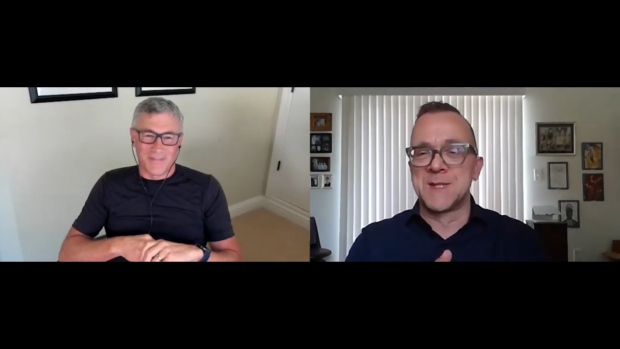Trov may be the only InsurTech that began its existence with less than six degrees of separation from the likes of Barbra Streisand and Steven Spielberg.
Early business plan pitches brought the company tantalizingly close to both, as well as other celebrities, recalled Trov Founder, Chairman and CEO Scott Walchek.
“We never got to pitch directly to those folks,” Walchek said. “It was always an intermediary, which was part of the problem, of course.”
Many startups might pack it in after the first or second revamp, as they work intensely to build an audience for their products and investors demand a return for their money. But Walchek has morphed Trov three times since its 2012 launch. The company pitches itself in its newest iteration as a “world leader in embedded insurance.” Insurance wasn’t part of the equation, however, until version 2.
Walchek, a charismatic leader with wavy salt-and-pepper hair and a low, husky voice, said his adaptation of the company has been about bringing value to investors and “employees who put their resources (and trust) at risk with me.” With that in mind, he said throwing in the towel has been out of the question.
 “We were called the Tinder of insurance. You could swipe right, swipe left to turn things on and off … We were billing it down to the second, which at the time was pretty interesting.” – Walchek on Trov’s foray into on-demand insurance.
“We were called the Tinder of insurance. You could swipe right, swipe left to turn things on and off … We were billing it down to the second, which at the time was pretty interesting.” – Walchek on Trov’s foray into on-demand insurance.
“New opportunities to leverage our team and technology to build a sustainable business model emerged, just as the models we’d earlier embraced waned—or perhaps because they were waning,” he said.
To be clear, startups typically revamp their early business models in multiple ways both large and small, according to Maureen Easton, a partner and business attorney at Foley & Lardner LLP.
“Many startups adjust their business model in small ways on a regular basis to stay competitive in the market,” Easton told Carrier Management. “When it comes to larger revamps, such as rebranding, shifting products or product lines, or changes to distribution models, many startups come to a point where they have to pivot due to changes in the industry in which they operate, overall economic pressures, customer preferences, workforce skills, and other internal and external factors.”
The fact that Trov has shifted its model three times by Walchek’s count isn’t necessarily unusual, she said.
“Larger revamps occur over the life of many companies, so it is hard to say whether [multiple revamps are] unusual for a single company,” Easton explained. “Larger business revamps are extensive undertakings and can be a lot for a company and its management team to take on.”
Sometimes those undertakings can be significant, Easton added. “Depending on the nature and scope of the revamp, the company is essentially starting an entirely new business each time.”
The First Time
Trov’s early days may be forgotten for many InsurTech watchers today, Walchek believes.
“I don’t think a lot of folks will remember…we launched in 2012,” he said candidly.
Trov’s origins focused on the notion that there is an asymmetry in control over data about the things people own.
“Our idea was if we can flip that asymmetry to benefit the customer or the individual—the consumer—rather than the intermediary or the e-commerce platform or what have you, then we could actually have impact for different markets,” Walchek recalled.
The initial platform allowed people to collect information about their things, he said, and that’s where Trov’s name came from.
“We called the repository for this digital collection about your things a Trov, as in treasure trove,” he said.
Trov initially focused on the high-net-worth space with this idea, under the notion that these clients had the most to gain from “tracking the ongoing value of their tangible wealth,” Walchek said.
Customer targets included wealth managers working on behalf of wealthy clients, with the proposition that “tangible assets can become a separate asset class that should be managed in the same way that intangible assets or more liquid assets are managed.”
It was a hard sell, Walchek said, because information about things people owned in the high-end space already existed as receipts, files or copies.
“Trying to get that into a digital world that we were able to manipulate and attract values up and down and find correlated information, and we could, say, keep the information fresh, was impossible to scale,” he added.
Still, Walchek and other Trov leaders pitched hard to intermediaries of Barbra Streisand, Michael Jordan, Steven Spielberg and Jeffrey Katzenberg, among others. It became clear, however, that traction was lacking, and after a year-and-a-half, it was time to shift gears.
Walchek and Trov began to eye younger generations for the company’s first, relatively minor revamp.
Adjustments Made
“It became obvious to us that the world had shifted and that those that were sort of entering into their most acquisitive years—the millennials, Gen X, Gen Z—that everything they acquire has digital exhaust associated with it,” Walchek said. “And if we could insert ourselves into that digital exhaust and then scrape or grab that information out in real time, and then automatically, if you would, fill up their personal ‘Trovs,’ that became phase 2, where we then moved to mobile-only.”
Walchek said that the company turned to “some of the interesting technologies available” and began targeting a younger demographic who were buying things online. It was the same company essentially, but with a new angle and pitch.
“I’m trying to remember what our actual tagline was, but it was about benefiting from everything that you own, and then essentially that it was a data play,” he said. “Again, it was all about taking advantage of the data that other enterprises are taking advantage of, and that benefit was going to be manifest through numerous ways.”
Clients of Trov’s platform could have comparison shopping and then easy ways to sell possessions they already owned, with everything in the process under their control.
The revamp led to an obvious question: How to monetize the new idea? This was around 2014, and Walchek came to a new revelation by that summer that led to a more dramatic reinvention.
Version 2: On-Demand Insurance
Walchek was invited to attend a special “think tank” gathering in Mirabelle, Switzerland that included investors from the firm Anthemis, now one of Trov’s major investors. He recalls talking with Kirsten Dunlop, then head of innovation at the Australian insurer (and future investor) Suncorp. They talked about his idea and the prospect of helping people collect information about their things, and how that data could have value, and then, as he recalls, something clicked.
Based on that conversation and other interactions between her team and the Trov team, the idea of on-demand insurance with micro-duration policies was born, Walchek recalled.
It took two more years to pivot and build out the idea, which led to an on-demand insurance platform that can protect anything a customer owns, for any duration, for any length of time, anywhere around the world. Customers could do all of this on a smart device.
The idea gelled as Trov hired insurance talent over the next few years to support the resulting growth, and Trov became a solid B2C business. There were sales and marketing hires, user experience development, and launches in Australia and the United Kingdom as well as the U.S.
 “What we see emerging is the consumers that we were going for directly back in 2015, 2016 and 2017 are now spending an enormous amount of time in their favorite e-commerce apps, particularly out in a post-COVID world. Everything’s coming online with massive shifts in behaviors and consumerism”—Walchek
“What we see emerging is the consumers that we were going for directly back in 2015, 2016 and 2017 are now spending an enormous amount of time in their favorite e-commerce apps, particularly out in a post-COVID world. Everything’s coming online with massive shifts in behaviors and consumerism”—Walchek“We were called the Tinder of insurance,” Walchek said, referring to the now-ubiquitous dating app. “You could swipe right, swipe left to turn things on and off…We were billing it down to the second, which at the time was pretty interesting.”
As Walchek remembers it, Trov’s platform caused a stir, generating “a bunch of interest in us,” and the company channeled that into partnerships and raising capital. Munich Re agreed to be Trov’s underwriter around the globe. Trov raised a $25.5 million Series C in 2016 and pulled in a $45 million Series D a year later, with Sompo Holdings signing on and agreeing to bring Trov to Japan.
But after hiring support folks, technical engineers and others, and reaching a high of 121 employees, it became clear the consumer business wasn’t leading to profit.
“The consumer acquisition costs were enormously high,” Walchek said. “Users engaged with it. They loved it. We had an immense amount of data, and we have greater information about how the modern consumer is engaging in their expectations around insurance. But…we were still paying between $200 and $300 per new user. And the average lifetime value of that user was probably going to be around $100.
“We have to buy customers, right? When it’s our brand and our product, then we have to buy customers. We have to attract them, and insurance is the most expensive proposition in advertising.”
Walchek and Trov began to see the limits of B2C for their technology. This began a morph into the company’s third, and current, version.
Version 3: Embedded Insurance
Sensing opportunity, Walchek noted that Trov most recently began to turn to a B2B model, where the company can be a bridge between insurers’ underwriting capacity and digital consumer brands.
“What we see emerging is the consumers that we were going for directly back in 2015, 2016 and 2017 are now spending an enormous amount of time in their favorite e-commerce apps, particularly out in a post-COVID world. Everything’s coming online with massive shifts in behaviors and consumerism,” Walchek said.
That behavior switch, he noted, has given rise to the movement of having the option to buy insurance embedded “in the user journeys” of these platforms. In other words, purchases for one thing could also include optional insurance and everything else.

But Walchek said that capacity providers don’t necessarily have the ability to connect digitally to this degree. Carriers are left as a result looking for ways to ignite “digital affinity” and pursue new embedded options for distributing insurance. That’s where Trov comes in now: B2B to C, handling functionality for third-party insurance clients to help them reach consumers.
“We don’t take the balance sheet risk, and we’re also using essentially all the brand equity that’s been developed by these digital consumer brands who are now starving for ways to offer new digital products with…high margin recurring revenue to their customers, and insurance is a perfect way to do that,” Walchek said. “We are empowering that.”
That means Trov’s consumer business from version 2 is now cut off, a process that began in 2018. Trov today is also leaner, now based only in the U.S. and UK.
The challenge, Walchek noted, is to develop awareness of Trov as it is now: a company that empowers digital sellers “to put their brand on an insurance product underwritten by one of our insurance underwriters but powered by Trov’s technology.”
Walchek said Trov’s investors have been supportive and that the company sees “lots of opportunity” in the embedded insurance space.”
There’s opportunity to be found in being flexible about revamping a company as needed, Walchek emphasized. It’s part of a philosophy he explains at every startup he has been a part of. At each one he’s launched over the years, he’ll have a kick-off company meeting where he shows some slides. One is of two images side-by-side: a picture of a finished residential kitchen and a ship under construction.
“I say: ‘We’re a ship, not a kitchen,'” Walchek explained. “All the joints of a ship…have to be built loosely because they’re going to change, because the water and the motion and the navigation of tumult and what have you is going to change this thing, and it has to be able to be loosely put together versus a kitchen, where the joints are tight.”
He then typically adds the follow-up statement, “We’re a ship and not a kitchen. And I think the success of any startup is going to be around paying attention to that sort of difference.”





















 ‘Dream Is in Sight:’ Chamber, Reinsurers, Insurers Urge Florida to Stay the Course
‘Dream Is in Sight:’ Chamber, Reinsurers, Insurers Urge Florida to Stay the Course  AI in Property/Casualty Insurance: Why Trusted Data Is the Missing Link
AI in Property/Casualty Insurance: Why Trusted Data Is the Missing Link  New York Times Sues Perplexity AI for ‘Illegal’ Copying of Content
New York Times Sues Perplexity AI for ‘Illegal’ Copying of Content  Police Recover Swallowed Fabergé Pendant 6 Days After it Was Stolen
Police Recover Swallowed Fabergé Pendant 6 Days After it Was Stolen 












